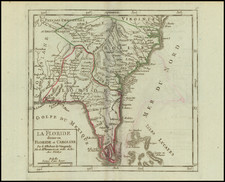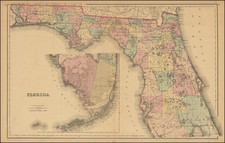Antique Map / Sea Chart of the Florida Keys -- from Key Largo and Middle Key to Lower Matecumbe and Rabbit Key.
Rare separately issued sea chart on heavy paper, showing the area between Lower Matecumbe Key and Key Largo, centered on the Plantation Key area.
The chart notes that it was first issued in 1863 and is based upon:
- Triangulation by Totten, Seward and Fairfield (1853-60)
- Topography by Dorr, Iardella, Wainwright and Oltmanns (1854-70)
- Hydrography by Craven, Moser, Davidson and Cordell (1855-90)
The Davidson referenced above is George Davidson, the most important west coast mapmaker of the 19th Century.
This is the first time we have ever seen this chart on the market.
The United States Office of the Coast Survey began in 1807, when Thomas Jefferson founded the Survey of the Coast. However, the fledgling office was plagued by the War of 1812 and disagreements over whether it should be civilian or military controlled. The entity was re-founded in 1832 with Ferdinand Rudolph Hassler as its superintendent. Although a civilian agency, many military officers served the office; army officers tended to perform the topographic surveys, while naval officers conducted the hydrographic work.
The Survey’s history was greatly affected by larger events in American history. During the Civil War, while the agency was led by Alexander Dallas Bache (Benjamin Franklin’s grandson), the Survey provided the Union army with charts. Survey personnel accompanied blockading squadrons in the field, making new charts in the process.
After the Civil War, as the country was settled, the Coast Survey sent parties to make new maps, employing scientists and naturalists like John Muir and Louis Agassiz in the process. By 1926, the Survey expanded their purview further to include aeronautical charts. During the Great Depression, the Coast Survey employed over 10,000 people and in the Second World War the office oversaw the production of 100 million maps for the Allies. Since 1970, the Coastal and Geodetic Survey has formed part of the National Oceanic and Atmospheric Administration (NOAA) and it is still producing navigational products and services today.









![Boca y Barra Del Rio Sta. Maria [Florida]](https://storage.googleapis.com/raremaps/img/small/43885.jpg)



![[ Florida Indians ] Ceremonia a Saturioua in expeditionem adversus hostes profecturo, observatae. XI](https://storage.googleapis.com/raremaps/img/small/86474.jpg)
